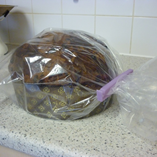 Here on Long Island, New York we have a ever-growing wine country on the East End of the Island. My wife and I like to go visit a few different wineries and enjoy sampling the different varieties of wine available. There is nothing more relaxing than to sit down with some good wine, cheese and bread and enjoy the cooler autumn air.
Here on Long Island, New York we have a ever-growing wine country on the East End of the Island. My wife and I like to go visit a few different wineries and enjoy sampling the different varieties of wine available. There is nothing more relaxing than to sit down with some good wine, cheese and bread and enjoy the cooler autumn air.
Last weekend we visited a few wineries we like after picking some pumpkins and it inspired me to try to incorporate one of the chardonnay from Mattebella vineyards into my next bake.
I decided to make a variation on my multi-grain soaker bread and also incorporated some roasted sweet potatoes in the mix along with freshly ground spelt flour and soft white wheat flour.
The soaker was made up of rolled oats, bulgur, millet and malted flakes.

I also decided to try being a little stylish with these loaves and used a snow flake cookie cutter to create an interesting effect. On one loaf I brushed it with an egg white mixed with water and sprinkled on some chia seeds.
AP Starter
227 grams AP Flour
71 grams AP Seed Starter
151 grams Water at Room Temperature (80-90 degrees F.)
Mix ingredients in a bowl until thoroughly combined. Cover the bowl and let it sit at room temperature for around 8 hours. The starter should almost double when ready to proceed. You can either mix in final dough or put in refrigerator for at most 1 day before using. If your kitchen is warmer than mine which is usually about 70-72 degrees with my air-conditioning you can proceed sooner.
Soaker
70 grams Rolled Oats
50 grams Bulgar Wheat
30 grams Millet
25 grams Malted Wheat Flakes
275 grams Boiling Water
Mix ingredients together in a bowl and cover. Let rest for 30 minutes or longer until ready to use.
Drain the liquid before mixing in the final dough. (Note: most of the liquid will get absorbed by the soaker ingredients which will help make this a fairly wet dough)
Main Dough Ingredients
425 grams Refreshed AP Starter (65% hydration) from above
All of the Soaker from above with water drained
50 grams Rye Chops
141 Freshly Ground and Sifted Spelt Flour
50 grams Wheat Germ
225 European Style Flour from KAF (can substitute Bread Flour)
130 grams Freshly Ground Soft Wheat Flour
160 grams Roasted and Mashed Sweet Potatoes
14 grams Sea Salt or Table Salt
268 grams White Wine (I used a Dry Chardonnay)
Procedure
Mix the flours with the wine and starter leaving 50 grams of wine for later in your mixer or by hand for 1 minute. Let the dough autolyse for one hour in your bowl and make sure to cover it. Next add in the salt, potatoes and the soaker with the balance of the wind and mix by hand for 2 minutes until everything is well incorporated. Mix on speed #1 for 2 minutes and speed #2 for 2 minutes or by hand for 5 minutes.
Next take the dough out of the bowl and place it on your work surface. Do a stretch and fold and rest the dough uncovered for 10 minutes. After the rest do another stretch and fold and cover the dough and let it rest for 10 minutes. Do one more stretch and fold and put the dough into a lightly oiled bowl and let it sit at room temperature covered for 2 hours. After 2 hours you can put the dough into the refrigerator for 24 hours or up to 2 days before baking. Feel free to do some additional S & F's if you feel it is necessary. I baked the bread about 24 hours later.
The next day (or when ready to bake) let the dough sit out at room temperature for 2 hours.
Next, form the dough into your desired shape and put them in floured bannetons, bowls or on a baking sheet and let them rise covered for 2 hours or until they pass the poke test. If you want to make the pattern on top, press your cookie cutter into the dough and place it good side up in a floured basket to rise. When ready to bake, make an egg wash or use some milk and brush on to the top of the loaf you want to add seeds to. Sprinkle the seeds on and then proceed to score the loaves as desired and prepare your oven for baking with steam.
Set your oven for 500 degrees F. at least 30 minutes before ready to bake. When ready to bake place the loaves into your on your oven stone with steam and lower the temperature immediately to 450 degrees. The total baking time was around 45 minutes. When both loaves are golden brown and reached an internal temperature of 200 degrees F. you can remove them from the oven.
Let the loaves cool down for at least an 6 hours or so before eating as desired.
Since there are so many different grains and flours in this bread the wine flavor is not very apparent. The final bread did come out very nice with a nice moist crumb and thick crust. This is a hearty bread and if you don't like whole grains you will not like this one. I just ate some for breakfast with some nice Havarti style cheese.
Please feel free to visit my other blog at www.mookielovesbread.wordpress.com for all my recipes.








































